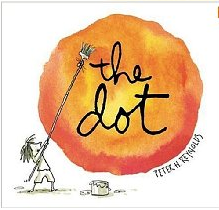 Every year, I start each of my Art classes by going over my "Art Rules". While this is review for most of my students, it never hurts to hear it again! And reading this book provides a great on-ramp to having this discussion!
Every year, I start each of my Art classes by going over my "Art Rules". While this is review for most of my students, it never hurts to hear it again! And reading this book provides a great on-ramp to having this discussion! The Dot, by Peter Reynolds, has to be one of my favorite children's books of all time. If you only read one art-themed book to your students this year, this should be the one! This is the story of a young girl named Vashti who, intimidated by a blank piece of paper announces, "I just CAN"T draw!", (breaking Rule #3!). Her very wise teacher is able to get her past her artistic block through the use of inspiration and encouragement, and then instill in her the confidence to keep going. This is a book you can (and will!) refer back to many times, so it's a great way to kick off the new school year! I read this to my first graders, then use it as inspiration for decorating the front of their portfolios:
The Dot, by Peter Reynolds, has to be one of my favorite children's books of all time. If you only read one art-themed book to your students this year, this should be the one! This is the story of a young girl named Vashti who, intimidated by a blank piece of paper announces, "I just CAN"T draw!", (breaking Rule #3!). Her very wise teacher is able to get her past her artistic block through the use of inspiration and encouragement, and then instill in her the confidence to keep going. This is a book you can (and will!) refer back to many times, so it's a great way to kick off the new school year! I read this to my first graders, then use it as inspiration for decorating the front of their portfolios:1. Do a quick review of the color wheel and how to mix secondary colors from primary colors. (A color wheel poster is a handy tool to have for this purpose! Here is another color wheel poster that is great for older kids.)
2. Using watercolors, paint a dot (about the size of a cherry) in the center of your portfolio. This is a good time to talk about the often over-powering characteristics of the color "black"! Tell students that they are only to use black in tiny amounts, mixed with other colors, to change the look of those colors, but not to turn those colors completely black. If necessary, you can tell students not to use the black at all on this project or (if you use the Prang refillable sets) you can even pop the blacks out of all the paint sets before passing out materials..... you know your students best!
3. After you paint your dot, mix a new color and, starting at the outside edge, paint around your dot, making it bigger.
4. Continue doing this, experimenting with new colors and mixes each time, until your dot reaches from the bottom of your portfolio to the top where it opens. Try not to go over and over areas you've already painted because that could make your colors look "muddy"!
5. When your dot has reached "full size", you may go back and selectively add a few touches of contrasting color here and there, to jazz it up a little. Don't get too carried away with this step - a few extra splashes of color is all you need!
5. As a final step, "Sign it!", in the lower right corner, where an artist signs his work!!
This project presents a great opportunity to review the care and use of watercolors.... how much water to add, the proper way to rinse your brush, how to use the mixing wells in the lid, and how to clean both the lid and the colors themselves when you're finished, so the set looks good for the next student who gets it!
(Tip: Sometimes railroad board can have a shiny side and a dull side. Always make sure that the medium you are using will "stick" to the front of your portfolios! Test it first, before you make your portfolios, to determine which side to have facing out when you fold them.)
No comments:
Post a Comment